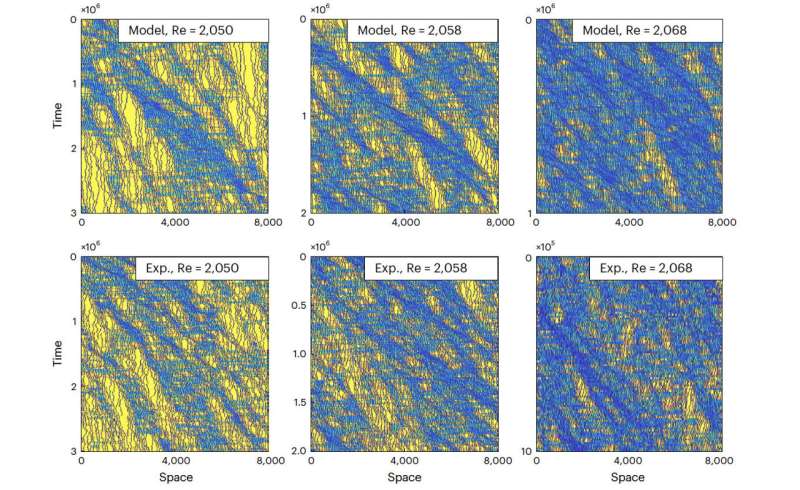This article has been reviewed according to Science X's editorial process and policies. Editors have highlighted the following attributes while ensuring the content's credibility:
fact-checked
peer-reviewed publication
trusted source
proofread
The unexpected connection between brewing coffee and understanding turbulence

In 1883, Osborne Reynolds injected ink into water in a short, clear pipe to observe its movement. His experiments showed that as the input water velocity increased, the flow went from laminar (smooth and predictable) to turbulent (unsteady and unpredictable) through the development of localized patches of turbulence, known today as "puffs."
His work helped launch the field of fluid mechanics, but, as experiments often do, it raised more questions. For example, why do these transitions between laminar and turbulent flows occur and how can the transitions be characterized quantitatively?
Although Reynolds was not able to find the answer, an international team of researchers, led by University of California San Diego Chancellor's Distinguished Professor of Physics Nigel Goldenfeld and Björn Hof of the Institute of Science and Technology Austria have used statistical mechanics to solve this longstanding problem. Their work appears in Nature Physics.
One of the novelties of this work was that the team looked at the problem not only from the perspective of fluid mechanics, but also through statistical mechanics—the branch of physics that uses mathematics to describe the behavior of systems with a large number of particles. Usually this is applied to systems in equilibrium, but turbulence is not in equilibrium, because energy is constantly moving in and out of the fluid.
However, building on their earlier work, the team showed that fluids move through a pipe in a non-equilibrium phase transition, known as directed percolation, at the transition point between laminar and turbulent flow. If "percolation" makes you think of your morning coffee, it provides a useful example here.
A storm in a coffee cup
When coffee is percolating, water moves through coffee grounds at a certain rate and flows downward in the direction of gravity. This flow is known as directed percolation. Too fast and the coffee is weak; too slow and the water backs up and spills onto the counter.
The best cup of coffee is one where the water flows at a rate slow enough to absorb the most flavor from the beans, but fast enough that it passes through the filter without backing up. And this best cup of coffee occurs at what is known as the directed percolation transition.
This may not seem relevant to fluid turbulence, but in earlier work, the team and other researchers in the field had evidence that the directed percolation transition had the same statistical properties as laminar-turbulent transitions.
"This problem has been around for nearly 150 years and required a bit of unconventional thinking to solve," said Goldenfeld, who also holds appointments in the Jacobs School of Engineering and the Halicioğlu Data Science Institute. "And time. Some of the team members have been working on this aspect of the problem for well over a decade."
Indeed, in 2016, the Hof group studied the laminar-turbulent transition experimentally in a circular geometry, at the same time that Goldenfeld and collaborators developed their theory of the laminar-turbulent transition.
Although the Hof group had demonstrated directed percolation in a circular geometry, what happens in an open geometry like a pipe remained unclear. Moreover, the experiments are impractical to do in a pipe geometry. While a circle is never-ending, the researchers estimated that to perform the same experiment in a pipe would require a length of 2.5 miles, and it would take centuries to collect the necessary data points.
To make progress, the team did two things. First, they used pressure sensors to observe the puffs in a pipe, and measured precisely how the puffs influenced each other's motion. Inputting the data into a molecular dynamics computer simulation, they were able to show that statistically, near the laminar-turbulent transition, puff behavior was in excellent agreement with the directed percolation transition.
Second, they used statistical mechanics to mathematically predict the behavior of the puffs, using techniques from phase transition physics. This too validated the hypothesis of a directed percolation transition.
Through this research, the team also discovered something unexpected from both the detailed experiments and the statistical mechanical theory: like cars on the freeway in rush hour, puffs are prone to traffic jams. If a puff fills the width of a pipe, nothing can move past it, which means other puffs may build up behind it.
And just as you might wonder why traffic jams occur and why they clear up with no identifiable cause, puff jams can also form and dissipate on their own, in a way that statistical mechanics describe. Puff jams tend to "melt" at the critical transition point from laminar to turbulent flow, giving way to the special statistical behavior of the directed percolation transition.
Goldenfeld commented, "This work not only closes one chapter on the laminar-turbulent transition in pipes, but shows how insights from different scientific disciplines can unexpectedly illuminate a difficult problem. Without a statistical mechanics perspective, understanding this quintessential fluid mechanics phenomenon would have been impossible."
The full list of authors includes Nigel Goldenfeld (UC San Diego), Björn Hof and Vasudevan Mukund (both Institute of Science and Technology Austria), Hong-Yan Shih (Institute of Physics, Academia Sinica (Taiwan)), Gaute Linga (the Njord Center, University of Oslo), Joachim Mathiesen (Niels Bohr Institute, University of Copenhagen), and Grégoire Lemoult (Université Le Havre Normandie).
More information: Grégoire Lemoult et al, Directed percolation and puff jamming near the transition to pipe turbulence, Nature Physics (2024). DOI: 10.1038/s41567-024-02513-0
Journal information: Nature Physics
Provided by University of California - San Diego





















